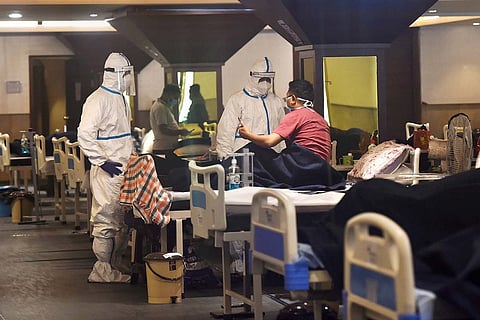

The COVID-19 second wave is expected to peak over the next two to three weeks, according to experts. But one significant difference between the first surge of the coronavirus and what we are witnessing now is the number of youngsters getting infected. Several young children have also tested positive for the novel coronavirus in this wave. Much like in other parts of the country, Bengaluru’s second wave too is being driven by those between the age group of 15-45 years.
Speaking to TNM, the Karnataka Health Minister Dr K Sudhakar confirmed this trend. “Figures show that 47% or 38,256 of the total 67,298 people who tested positive between March 5 and April 5 are in the 15-45 age group,” he said.
“Among this about 19,378 cases are in the 15-29 age group, 18,853 are in the 30-44 age group and 14,978 are in the 45-59 age group. However, if you consider mortality out of 307 deaths, 214 are deaths are among people aged above 60 years followed by 76 deaths in the 45-59 age group. So, the vulnerable group is still the senior citizens and people aged above 45,” Dr Sudhakar added.
While the first wave of the coronavirus was said to impact the elderly the most, the second wave increasingly seems to target the young as evidenced by the numbers. But doctors and experts say it may be on account of the fact that younger people are more mobile. Dr Sudarshan Ballal who is the Chairman of Manipal Hospitals said that numbers depict that the current variants are spreading through younger people. “This strain is affecting a lot more youngsters between the age group of 22 to 48 years old. This is one of the problems because the younger age groups are more mobile and are more seen in large crowds,” Dr Ballal added.
This phenomenon could have a far-reaching impact as youngsters will act as carriers affecting the vulnerable population more. Dr Ballal, confirming the same, said, “ Most youngsters may be asymptomatic so they might not isolate themselves and end up spreading the disease to other groups like the elderly and people with comorbidities.
Dr Sudharshan Ballal is also on the experts’ panel advising the Chief Minister of Karnataka on steps to be taken to tackle the pandemic. “We do not have enough data at this point of time to conclusively say that this strain of the coronavirus affects the younger people more than the elderly lot. But it is known that the mutant spreads faster because it can attach to your respiratory cells easier than the other one. So it can be seen as a respiratory virus that can spread through aerosol or through close contact,” he explained.
Karnataka Chief Minister BS Yediyurappa has so far refused to impose a lockdown and while a night curfew is in place in Bengaluru and other cities, gathering and free movement of public has led to increasing numbers with the city contributing a large chunk of the positive cases in the state. Bruhat Bengaluru Mahanagara Palike (BBMP) Commissioner Gaurav Gupta told TNM that testing patterns reveal that most cases reported in Bengaluru are from the age group of 30-45 years. But I'm also told that some of the cases are deteriorating even in relatively younger people. So it's not only the elderly who have fatalities, it's getting significant even in the younger group”.
Speaking of the reasons for the surge of positive cases in youngsters, Gaurav Gupta said, “This is maybe because they are more mobile. I think scientists and researchers are trying to understand why this is. I hear in Brazil even the kids are contracting. The only thing we can do now is to maintain COVID-appropriate behavior and keep it under control”.